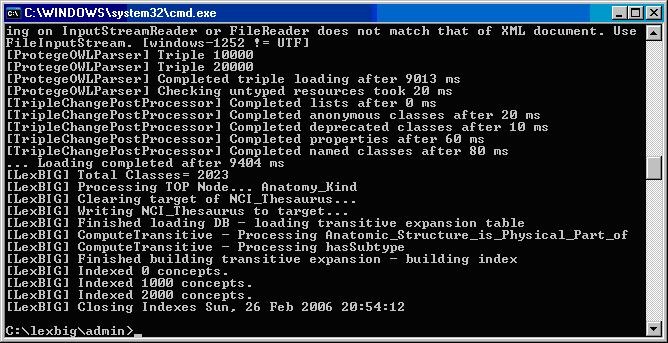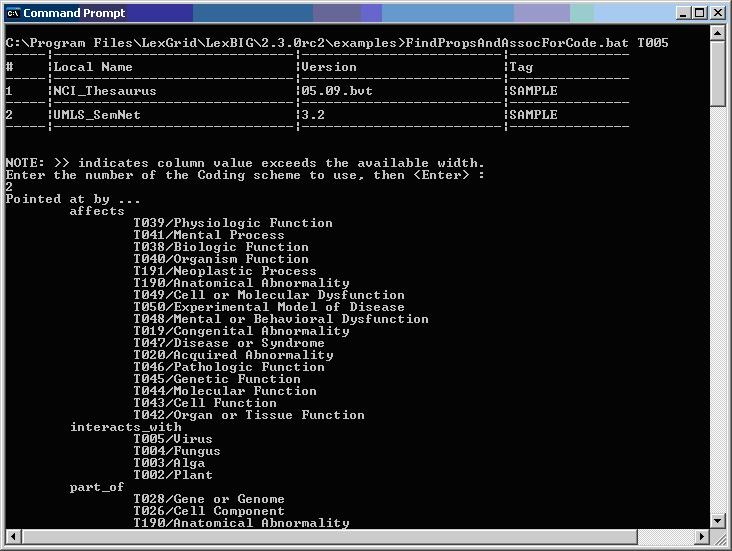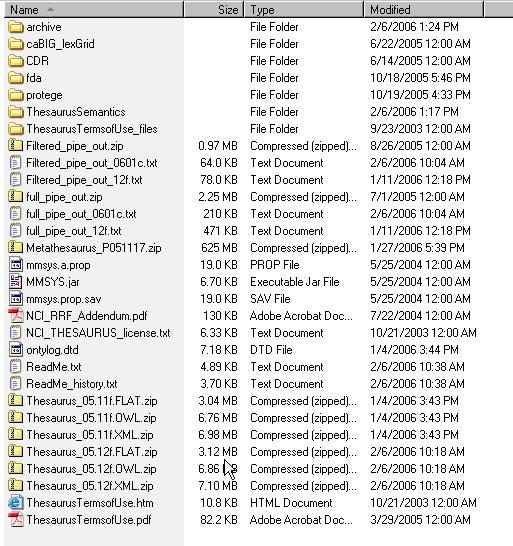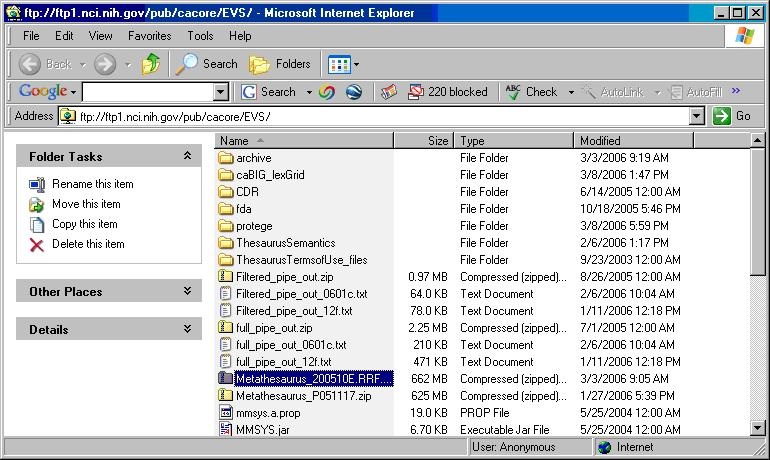<?xml version="1.0" encoding="utf-8"?>
<html>
Introduction
This document is a section of the Administration Guide.
Vocabulary administration overview
A set of administrative utilities are provided to manage the LexEVS Service. These utilities are provided for Windows (.bat) and Linux (.sh) operating systems. Each of the commands is located in the <tt>{LEXBIG_DIRECTORY}/admin</tt> and <tt>{LEXBIG_DIRECTORY}/test directory.</tt> A full description of the options with example is provided for each of the administration utilities.
Administrative Program |
Description |
|---|---|
ActivateScheme |
Activates a coding scheme based on unique URN and version. |
Options:
u,-urn <urn> URN uniquely identifying the code system.
v,-version <versionId> Version identifier.
f,-force Force activation (no confirmation).
Example:
ActivateScheme -u "urn:oid:2.16.840.1.113883.3.26.1.1" -v "05.09e" |
ClearOrphanedResources |
Clean up orphaned resources - databases and indexes. |
Options:
li,-listIndexes List all unused indexes.
ldb,-listDatabases List all unused databases (with matching prefix).
ri,-removeIndex <name> Remove the (unused) index with the given name.
rdb,-removeDatabase <name> Remove the (unused) database with the given name.
a,-all Remove all unreferenced indexes and databases (with matching prefix).
Example: ClearOrphanedResources -li |
DeactivateScheme |
Deactivates a coding scheme based on unique URN and version. |
Options:
u,-urn <urn> URN uniquely identifying the code system.
v,-version <versionId> Version identifier.
d,-date <yyyy-MM-dd,HH:mm:ss> Date and time for deactivation to take effect; immediate if not specified.
f,-force Force deactivation (no confirmation).
Example:
DeactivateScheme -u "urn:oid:2.16.840.1.113883.3.26.1.1" -v "05.09e" -d "01/31/2099,12:00:00" |
ExportLgXML |
Exports content from the repository to a file in the LexGrid canonical XML format. |
Options:
out,-output <uri> URI or path of the directory to contain the resulting XML file. The file name will be automatically derived from the coding scheme name.
u,-urn <name> URN or local name of the coding scheme to export.
v,-version <id> The assigned tag/label or absolute version identifier of the coding scheme.
nf,-noFail If specified, indicates that processing should not stop for recoverable errors
f,-force If specified, allows the destination file to be overwritten if present.
Note: If the coding scheme and version values are unspecified, a list of available coding schemes will be presented for user selection.
Example: ExportLgXML -out "file:///path/to/dir" -nf -f
Example: ExportLgXML -out "file:///path/to/dir" u "NCI_Thesaurus" -v "PRODUCTION" -nf -f |
ExportOBO |
Exports content from the repository to a file in the Open Biomedical Ontologies (OBO) format. |
Options:
out,-output <uri> URI or path of the directory to contain the resulting OBO file. The file name will be automatically derived from the coding scheme name.
u,-urn <name> URN or local name of the coding scheme to export.
v,-version <id> The assigned tag/label or absolute version identifier of the coding scheme.
nf,-noFail If specified, indicates that processing should not stop for recoverable errors
f,-force If specified, allows the destination file to be overwritten if present.
Note: If the coding scheme and version values are unspecified, a list of available coding schemes will be presented for user selection.
Example: ExportOBO -out "file:///path/to/dir" -nf -f
Example: ExportOBO -out "file:///path/to/dir" -u "FBbt" -v "PRODUCTION" -nf -f |
ExportOWL |
Exports content from the repository to a file in OWL format. |
Options:
out,-output <uri> URI or path of the directory to contain the resulting OWL file. The file name will be automatically derived from the coding scheme name.
u,-urn <name> URN or local name of the coding scheme to export.
v,-version <id> The assigned tag/label or absolute version identifier of the coding scheme.
nf,-noFail If specified, indicates that processing should not stop for recoverable errors
f,-force If specified, allows the destination file to be overwritten if present.
Note: If the URN and version values are unspecified, a list of available coding schemes will be presented for user selection.
Example: ExportOWL -out "file:///path/to/dir" -nf -f
Example: ExportOWL -out "file:///path/to/dir" -u "sample" -v "1.0" -nf -f |
ListExtensions |
List registered extensions to the LexEVS runtime environment. |
Options:
a,-all List all extensions (default, override by specifying other options).
i,-index List index extensions.
m,-match List match algorithm extensions.
s,-sort List sort algorithm extensions.
g,-generic List generic extensions.
Example:
ListExtensions -a |
ListSchemes |
List all currently registered vocabularies. |
Example:
ListSchemes |
LoadLgXML |
Loads a vocabulary file, provided in LexGrid canonical xml format. |
Options:
in,-input <uri> URI specifying location of the source file.
-v, --validate <level> Perform validation of the candidate resource without loading data. If specified, the '-nf', -a' and '-t' options are ignored. Supported levels of validation include:
0 = Verify document is well-formed
1 = Verify document is valid
nf,-noFail If specified, indicates that processing should not stop for recoverable errors.
-a, --activate ActivateScheme on successful load; if unspecified the vocabulary is loaded but not activated.
-t, --tag <tagID> An optional tag ID (e.g. 'PRODUCTION' or 'TEST') to assign.
Load Example:
LoadLgXML -in "file:///path/to/file.xml" -nf -a
Validation Example:
LoadLgXML -in "file:///path/to/file.xml" -v 0 |
LoadNCIHistory |
Imports NCI History data to the LexEVS repository. |
Options:
in,-input <uri> URI specifying location of the history file
vf,-versionFile <uri> URI specifying location of the file containing version identifiers for the history to be loaded.
-v, --validate <level> Perform validation of the candidate resource without loading data. If specified, the '-nf' and '-r' options are ignored. Supported levels of validation include:
0 = Verify top 10 lines are correct format
1 = Verify correct format for the entire file
nf,-noFail If specified, indicates that processing should not stop for recoverable errors
-r, --replace If not specified, the provided history file will be added into the current history database; otherwise the current database will be replaced by the new content.
Load Example:
LoadNCIHistory -nf -in "file:///path/to/history.file" -vf "file:///path/to/version.file"
Validation Example:
LoadNCIHistory -in "file:///path/to/history.file" -v 0
Versions File format information:
releaseDate | isLatest | releaseAgency | releaseId | releaseOrder | entityDescription
Sample record:
28-NOV-05 | false | http://nci.nih.gov/![]() | 05.10e | 26 | Editing of NCI Thesaurus 05.10e was completed on October 31, 2005. Version 05.10e was October's fifth build in our development cycle. |
| 05.10e | 26 | Editing of NCI Thesaurus 05.10e was completed on October 31, 2005. Version 05.10e was October's fifth build in our development cycle. |
LoadNCIMeta |
Loads the NCI MetaThesaurus, provided as a collection of RRF files. |
Options:
in,-input <uri> The directory containing the RRF files; in URI format.
-v, --validate <level> Perform validation of the candidate resource without loading data. If specified, the '-nf', -a' and '-t' options are ignored. Supported levels of validation include:
0 = Verify first 1000 lines per required file
nf,-noFail If specified, indicates that processing should not stop for recoverable errors
-a, --activate ActivateScheme on successful load; if unspecified the vocabulary is loaded but not activated
-t, --tag <tagID> An optional tag ID (e.g. 'PRODUCTION' or 'TEST') to assign.
Load Example:
LoadNCIMeta -in "file:///path/to/directory" -nf -a
Validation Example:
LoadNCIMeta -in "file:///path/to/directory" -v 0 |
LoadNCIThesOWL |
Loads an OWL file containing a version of the NCI Thesaurus ... |
Options:
in,-input <uri> URI specifying location of the source file
-v, --validate <level> Perform validation of the candidate resource without loading data. If specified, the '-nf', -a' and '-t' options are ignored. Supported levels of validation include:
0 = Verify document is well-formed
1 = Verify document is valid
nf,-noFail If specified, indicates that processing should not stop for recoverable errors.
-a, --activate ActivateScheme on successful load; if unspecified the vocabulary is loaded but not activated.
-t, --tag <tagID> An optional tag ID (e.g. 'PRODUCTION' or 'TEST') to assign.
Load Example:
LoadNCIThesOWL -in "file:///path/to/thesaurus.owl" -nf -a
Validation Example:
LoadNCIThesOWL -in "file:///path/to/thesaurus.owl" -v 0 |
LoadOBO |
Loads a file specified in the Open Biomedical Ontologies (OBO) format.
Options:
in,-input <uri> URI or path specifying location of the source file
-v, --validate <int> Perform validation of the candidate resource without loading data. If specified, the '-nf', -a' and '-t' options are ignored. Supported levels of validation include:
0 = Verify document is valid
nf,-noFail If specified, indicates that processing should not stop for recoverable errors
-a, --activate ActivateScheme on successful load; if unspecified the vocabulary is loaded but not activated
-t, --tag <id> An optional tag ID (e.g. 'PRODUCTION' or 'TEST') to assign.
Example: LoadOBO -in "file:///path/to/file.obo" -nf -a
LoadOBO -in "file:///path/to/file.obo" -v 0 |
LoadOWL |
Loads an OWL file. |
Note: Load of the NCI Thesaurus should be performed via the LoadNCIThesOWL counterpart, since it will allow more precise handling of NCI semantics.
Options:
in,-input <uri> URI or path specifying location of the source file
-v, --validate <int> Perform validation of the candidate resource without loading data. If specified, the '-nf', -a' and '-t' options are ignored. Supported levels of validation include:
0 = Verify document is well-formed
1 = Verify document is valid
nf,-noFail If specified, indicates that processing should not stop for recoverable errors
-a, --activate ActivateScheme on successful load; if unspecified the vocabulary is loaded but not activated
-t, --tag <id> An optional tag ID (e.g. 'PRODUCTION' or 'TEST') to assign.
Example: LoadOWL -in "file:///path/to/somefile.owl" -nf -a
LoadOWL -in "file:///path/to/somefile.owl" -v 0 |
LoadUMLSDatabase |
Loads UMLS content, provided as a collection of RRF files in a single directory. Files may comprise the entire UMLS distribution or pruned via the MetamorphoSys tool. A complete list of source vocabularies is available online at http://www.nlm.nih.gov/research/umls/metaa1.html. |
Options:
in,-input <uri> Location of the source database. Typically this is specified in the form of a URL that indicates the database server, port, name, and optional properties.
u,-uid User ID for authenticated access, if required and not specified as part of the input URL.
p,-pwd Password for authenticated access, if required and not specified as part of the input URL.
d,-driver Name of the JDBC driver to use when accessing the database.
s,-sources Comma-delimited list of source vocabularies to load.
If absent, all available vocabularies are loaded.
-v, --validate <int> Perform validation of the candidate resource without loading data. If specified, the '-nf', -a' and '-t' options are ignored. Supported levels of validation include:
0 = Verify the existence of each required file
nf,-noFail If specified, indicates that processing should not stop for recoverable errors
-a, --activate ActivateScheme on successful load; if unspecified the vocabulary is loaded but not activated.
-t, --tag <id> An optional tag ID (e.g. 'PRODUCTION' or 'TEST') to assign.
Example: LoadUMLSDatabase -in "jdbc:postgresql://localhost:5432/lexgrid"
-d "org.postgresql.Driver" -u "myDatabaseUser" -p "myPassword"
-s "ICD9CM_2005,ICD9CM_2006" -nf -a
LoadUMLSDatabase -in "jdbc:postgresql://localhost:5432/lexgrid"
-d "org.postgresql.Driver" -u "myDatabaseUser" -p "myPassword"
-v 0 |
LoadUMLSFiles |
Loads UMLS content, provided as a collection of RRF files in a single directory. Files may comprise the entire UMLS distribution or pruned via the MetamorphoSys tool. A complete list of source vocabularies is available online at http://www.nlm.nih.gov/research/umls/metaa1.html. |
Options:
in,-input <uri> URI or path of the directory containing the NLM files
s,-sources Comma-delimited list of source vocabularies to load.
If absent, all available vocabularies are loaded.
-v, --validate <int> Perform validation of the candidate resource without loading data. If specified, the '-nf', -a' and '-t' options are ignored. Supported levels of validation include:
0 = Verify the existence of each required file
nf,-noFail If specified, indicates that processing should not stop for recoverable errors
-a, --activate ActivateScheme on successful load; if unspecified the vocabulary is loaded but not activated.
-t, --tag <id> An optional tag ID (e.g. 'PRODUCTION' or 'TEST') to assign.
Example: LoadUMLSFiles -in "file:///path/to/directory/" -s "ICD9CM_2005,ICD9CM_2006" -nf -a
LoadUMLSFiles -in "file:///path/to/directory/" -v 0
Note: UMLS Metathesaurus RRF files are a very large fileset. Many users prefer to subset these files using the Metamorphosys tool included with the UMLS Metathesaurus in order to move a single terminology from a central location of these files. When generating source RRF files from the Metathesaurus, the Metamorphosys tool should be set to output versionless source abbreviations rather than versioned source abbreviations. Failing to do so before loading RRF files to LexEVS will cause an incomplete database to be created leaving the association and concept tables empty |
LoadUMLSSemnet |
Loads the UMLS Semantic Network, provided as a collection of files in a single directory. The following files are expected to be provided from the National Library of Medicine (NLM) distribution:
|
Options:
in,-input <uri> URI or path of the directory containing the NLM files
-v, --validate <int> Perform validation of the candidate resource without loading data. If specified, the '-nf', -a' and '-t' options are ignored. Supported levels of validation include:
0 = Verify the existence of each required file
nf,-noFail If specified, indicates that processing should not stop for recoverable errors
-a, --activate ActivateScheme on successful load; if unspecified the vocabulary is loaded but not activated.
-t, --tag <id> An optional tag ID (e.g. 'PRODUCTION' or 'TEST') to assign.
-il --InheritanceLevel <int> If specified, indicates the extent of inherited relationships to import.
0 = none; 1 = all; 2 = all except is_a (default). All direct relationships are imported, regardless of option.
Example: LoadUMLSSemnet -in "file:///path/to/directory/" -nf -a -il 1
LoadUMLSSemnet -in "file:///path/to/directory/" -v 0 |
LoadFMA |
Imports from an FMA database to a LexEVS repository. Requires that the pprj file be configured with a database URN, username, password for an FMA MySQL based database. The FMA.pprj file and MySQL dump file are available at http://sig.biostr.washington.edu/projects/fm/upon registration. |
Options:
in,-input <uri> URI or path specifying location of the source file
-v, --validate <int> Perform validation of the candidate resource without loading data. If specified, the '-nf', -a' and '-t' options are ignored. Supported levels of validation include:
0 = Verify document is well-formed
1 = Verify document is valid
nf,-noFail If specified, indicates that processing should not stop for recoverable errors
-a, --activate ActivateScheme on successful load; if unspecified the vocabulary is loaded but not activated
-t, --tag <id> An optional tag ID (e.g. 'PRODUCTION' or 'TEST') to assign.
Example: LoadFMA -in "file:///path/to/FMA.pprj" -nf -a
or
LoadFMA -in "file:///path/to/FMA.pprj" -v 0 |
LoadHL7RIM |
Converts an HL7 RIM MS Access database to a LexGrid database |
in,-input <uri> URI or path specifying location of the source file
mf,-manifest <uri> URI or path specifying location of the manifest file
lp,-load preferences <uri> URI or path specifying location of the load preferences file
-v, --validate <int> Perform validation of the candidate
resource without loading data. If specified, the '-nf', -a' and '-t' options are ignored. Supported levels of validation include:
0 = Verify document is valid
nf,-noFail If specified, indicates that processing should not stop for recoverable errors
-a, --activate ActivateScheme on successful load; if unspecified the vocabulary is loaded but not activated
-t, --tag <id> An optional tag ID (e.g. 'PRODUCTION' or 'TEST') to assign.
Example: LoadHL7RIM -in "file:///path/to/file.mdb" -nf -a
or
LoadHL7RIM -in "file:///path/to/file.mdb" -v 0 |
LoadMetaData |
Loads optional XML-based metadata to be associated with an existing coding scheme. u,-urn <name> URN uniquely identifying the code system. Note: If the URN and version values are unspecified, a list of available coding schemes will be presented for user selection. |
Example: LoadMetadata -in "file:///path/to/file.xml" -nf -o
or
LoadMetadata -in "file:///path/to/file.xml" |
RebuildIndex |
Rebuilds indexes associated with the specified coding scheme. |
Options:
u,-urn <urn> URN uniquely identifying the code system.
v,-version <versionId> Version identifier.
i,-index <name> Name of the index extension to rebuild (if absent, rebuilds all built-in indices and named extensions).
f,-force Force clear (no confirmation).
Example:
RebuildIndex -u "urn:oid:2.16.840.1.113883.3.26.1.1" -v "05.09e" -i "myindex" |
RemoveIndex |
Clears an optional named index associated with the specified coding scheme. Note: built-in indices required by the LexEVS runtime cannot be removed. |
Options
u,-urn <urn> URN uniquely identifying the code system.
v,-version <versionId> Version identifier.
i,-index <name> Name of the index extension to clear.
f,-force Force clear (no confirmation).
Example: RemoveIndex -u "urn:oid:2.16.840.1.113883.3.26.1.1" -v "05.09e" -i "myindex" |
RemoveScheme |
Removes a coding scheme based on unique URN and version. |
Options:
u,-urn <urn> URN uniquely identifying the code system.
v,-version <versionId> Version identifier.
f,-force Force deactivation and removal without confirmation.
Example:
RemoveScheme -u "urn:oid:2.16.840.1.113883.3.26.1.1" -v "05.09e" |
TagScheme |
Associates a tag ID (e.g. 'PRODUCTION' or 'TEST') with a coding scheme URN and version. |
Options:
u,-urn <urn> URN uniquely identifying the code system.
v,-version <versionId> Version identifier.
t,-tag The tag ID (e.g. 'PRODUCTION' or 'TEST') to assign.
Example:
TagScheme -u "urn:oid:2.16.840.1.113883.3.26.1.1" -v 05.09e" -t "TEST" |
TestRunner* |
*
Located in
/test
Note: the LexEVS runtime and database environments must still be configured prior to invoking the test suite. | Executes a suite of tests for the LexEVS installation.
Options:
b,-brief Runs the LexEVS test suite and produce a text report with overall statistics and details for failed tests only.
f,-full Runs the LexEVS test suite and produce an itemized list of all tests with indication of success/failure.
h,-html Runs the LexEVS test suite and produce a report suitable for view in a standard web browser.
x,-xml Runs the LexEVS test suite and produce a report with extensive information for each test case in xml format.
Example:
TestRunner -f -h |
TransferScheme |
Tool to help gather information necessary to transfer data from one SQL server to another. |
Options:
u,-urn The Coding Scheme URN or local name to transfer.
v,-version The version of the coding scheme to transfer.
Example:
TransferScheme -u "urn:oid:2.16.840.1.113883.3.26.1.1" -v 05.09e" |
Installing sample vocabularies
This LexEVS installation provides the UMLS Semantic Net and a sampling of the NCI Thesaurus content (sample.owl) that can be loaded into the database.
Step |
Action |
|---|---|
<center>1</center> |
In a Command Prompt window, enter <tt>*_cd |
/examples_*</tt> to go to the example programs. |
<center>2</center> |
To load the example vocabularies, run the appropriate LoadSampleData script (<tt>LoadSampleData.bat</tt> for Windows; <tt>LoadSampleData.sh</tt> for Linux). |
NOTE: |
Vocabularies should not be loaded until configuration of the LexEVS runtime and database server are complete. |
|---|

Figure 3 - Displays the successful load of the sample vocabulary file.
Running the sample query programs
A set of sample programs are provided in the {LEXBIG_DIRECTORY}/examples directory. To run the sample query programs successfully a vocabulary must have been loaded.
Step |
Action |
||||||||||||||||||||||||||||||||||||||||||
|---|---|---|---|---|---|---|---|---|---|---|---|---|---|---|---|---|---|---|---|---|---|---|---|---|---|---|---|---|---|---|---|---|---|---|---|---|---|---|---|---|---|---|---|
<center>1</center> |
Enter <tt>*_cd Unknown macro: {LEXBIG_DIRECTORY}
/examples_*</tt> |
Figure 4 - Sample program output for finding properties and associations for a given code.
Figure 4 - Output of example programs using sample vocabulary Installing NCI vocabulariesNCI Thesaurus vocabularyThis section describes the steps to download and install a full version of the NCI Thesaurus for the LexEVS Service.
<tt>*_cd Unknown macro: {LexBIG_DIRECTORY}
/admin_*</tt> For Windows installation use the following command <tt>*_LoadNCIThesOWL.bat -nf -in "file:/// Unknown macro: {NCI_THESAURUS_DIRECTORY}
/Thesaurus_05.12f.owl"_*</tt> For Linux installation use the following command <tt>*_LoadNCIThesOWL.sh -nf -in "file:/// /Thesaurus_05.12f.owl"_*</tt> |
Table 7 - Example output from load of NCI Thesaurus 05.12f ... NCI Metathesaurus vocabularyThis section describes the steps to download and install a full version of the NCI Metathesaurus for the LexEVS Service.
<tt>*_cd /admin_*</tt> For Windows installation use the following command <tt>*_LoadNCIMeta.bat -nf -in "file:/// Unknown macro: {NCI_METATHESAURUS_DIRECTORY}
/" _*</tt> For Linux installation use the following command <tt>*_LoadNCIMeta.sh -nf -in "file:/// Unknown macro: {NCI_THESAURUS_DIRECTORY}
/"_*</tt> |
NCI HistoryThis section describes the steps to download and install a history file for NCI Thesaurus.
<tt>*_cd Unknown macro: {LexBIG_DIRECTORY}
/admin_*</tt> For Windows installation use the following command <tt>*_LoadNCIHistory.bat -nf -in "file:/// Unknown macro: {NCI_HISTORY_DIRECTORY}
" -vf "file:///NCI_HISTORY_DIRECTORY}/VersionFile"_*</tt> For Linux installation use the following command <tt>*_LoadNCIHistory.sh -nf -in "file:/// " -vf "file:///NCI_HISTORY_DIRECTORY}/VersionFile" _*</tt> |
This file has to be provided to the load API on every load because you will need to maintain it in the future as each new release is made. We have created this file that should be valid as of today from the information that we found in the archive folder on your ftp server. You can find this file in the 'resources' directory of the LexEVS install.</tt> | Deactivating and removing a vocabularyThis section describes the steps to deactivate a coding scheme and remove coding scheme from LexEVS Service.
/admin_*</tt> |
||||||||||||||||||||||||||||||||||||||||||
<center>2</center> |
Use the DeactiveScheme utility to prevent access to coding scheme. Once a coding scheme is deactivated, client programs will not be able to access the content for the specific coding scheme and version. |
Example:
DeactivateScheme -u "urn:oid:2.16.840.1.113883.3.26.1.1" -v "05.12f" |
<center>3</center> |
Use RemoveScheme utility to remove coding scheme from LexEVS service and database. |
Example:
RemoveScheme -u "urn:oid:2.16.840.1.113883.3.26.1.1" -v "05.12f" |
Tagging a vocabulary
This section describes the steps to tag a coding scheme to be used via LexEVS API.
Step |
Action |
|---|---|
<center>1</center> |
Change directory to LexEVS administration directory Unknown macro: {LEXBIG_DIRECTORY}
/admin_*</tt> |
<center>2</center> |
Use the TagScheme to tag a coding system and version with a local tag name (e.g. PRODUCTION). This tag name can be used via LexEVS API for query restriction. |
Example:
TagScheme -u "urn:oid:2.16.840.1.113883.3.26.1.1" -v "05.12f" -t "PRODUCTION" |
</html>




